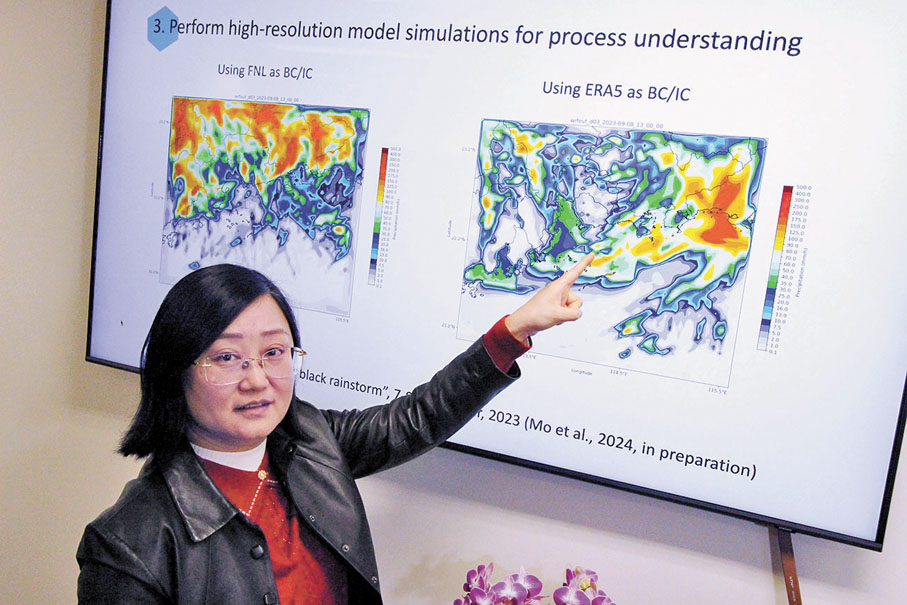Feature Interview|"Women in Science" – Satellite Hero Prof. Hui Su Hopes More Women Will Join the Frontiers of Research
In September 2022, Prof. Hui Su joined The Hong Kong University of Science and Technology (HKUST) from NASA and took part in leading the “HKUST–ALRIS-1” satellite project—the first Earth observation satellite led by Hong Kong’s higher education sector. The project aims to enhance precision forecasting of extreme weather events such as typhoons and heavy rainstorms, as well as monitor greenhouse gas emissions, particularly carbon dioxide, contributing actively to China’s “carbon neutrality” goals and global emission reduction efforts. During her time at NASA, Prof. Su was twice awarded the NASA Exceptional Achievement Medal, and last year received the Banner I. Miller Award from the American Meteorological Society in recognition of her outstanding contributions to advancing weather forecasting.

Prof. Hui Su encourages women scientists to seize every opportunity to shine. Photo by Wong Aili, Wen Wei Po.

Prof. Hui Su (front center) with her research team. Photo courtesy of interviewee.
The Hollywood filmHidden Figures, based on a true story, once captured hearts around the world by showing that women’s scientific contributions are no less than those of men. For Prof. Hui Su,Global STEM Professorin the Department of Civil and Environmental Engineering at the Hong Kong University of Science and Technology (HKUST) and former scientist at NASA’s Jet Propulsion Laboratory (JPL) for 17 years, that message still resonates deeply.
Speaking to Wen Wei Po, Prof. Su noted that more than half a century has passed since the era depicted in the film. Today, from NASA to Hong Kong, and around the world, the environment is far more supportive of women participating in science and technology. She believes that women’s attention to detail and ability to multitask offer natural strengths in balancing work and family, research and management. Prof. Su hopes to see more women break boundaries, pursue leadership roles with confidence, and make meaningful contributions to the world.
From NASA to Hong Kong: Leading Space Science for Climate Action
In September 2022, Prof. Su joined HKUST after nearly two decades at NASA, where she had twice received NASA’s Exceptional Achievement Medal. She now helps lead the "HKUST-FYBB#1" satellite project, Hong Kong’s first university-led satellite mission, designed to improve forecasting of extreme weather events like typhoons and heavy rainfall, while monitoring greenhouse gas emissions, particularly carbon dioxide.
Her work supports China’s carbon neutrality goals and global climate mitigation efforts. In recognition of her scientific achievements, Prof. Su was awarded theBanner I. Miller Awardby theAmerican Meteorological Societylast year for her contributions to improving weather prediction accuracy.
In an exclusive interview, Prof. Su shared that she was “born into a meteorological family”—both her parents worked at theSichuan Meteorological Bureau. This upbringing deeply influenced her academic journey. “Meteorology is closely tied to everyday life. What I study and research always feels relevant and real. There’s still so much to explore in this field—that's what keeps me motivated,” she said.
Rising Female Presence in Science—but Gaps Remain at the Top
Reflecting on her time as an undergraduate atPeking University, Prof. Su recalled that onlyabout 20% of studentsin science and engineering were women. Today, she’s encouraged to see female students make up nearly half in many universities. “It’s a very positive sign,” she said.
However, she acknowledged that the overall female participation rate in science is still not high, particularly in senior positions. “There are more women at entry-level roles, but far fewer who make it to full professorship or leadership positions. There’s still work to do, but the trend is moving in the right direction.”
Encouraging Signs of Female Participation in Science – A Call for More Women Leaders
Prof. Su drew inspiration fromHidden Figures, which depicts threeAfrican-American women at NASAin the 1960s who made pivotal contributions to the U.S. space program despite facinggender and racial discrimination. “Compared to those times, today’s women are incredibly fortunate. The whole societal environment is very supportive of women in science and technology,” she emphasized.
She noted that NASA now offers programs specifically designed to cultivate female leadership, and globally there is a growing appreciation for women in STEM (Science, Technology, Engineering, and Mathematics).
Prof. Su believes that women often possess greater sensitivity, broader perspective, and creativity, which can give them an edge in scientific research. “We’re usually better at multitasking, and that allows us to strike a good balance between managing research and administration, as well as work and family,” she said. “These qualities make women strong contributors to addressing global challenges and serving society through science.”
Source: Ta Kung Wen Wei Media
Link:https://bit.ly/44aBwKr




